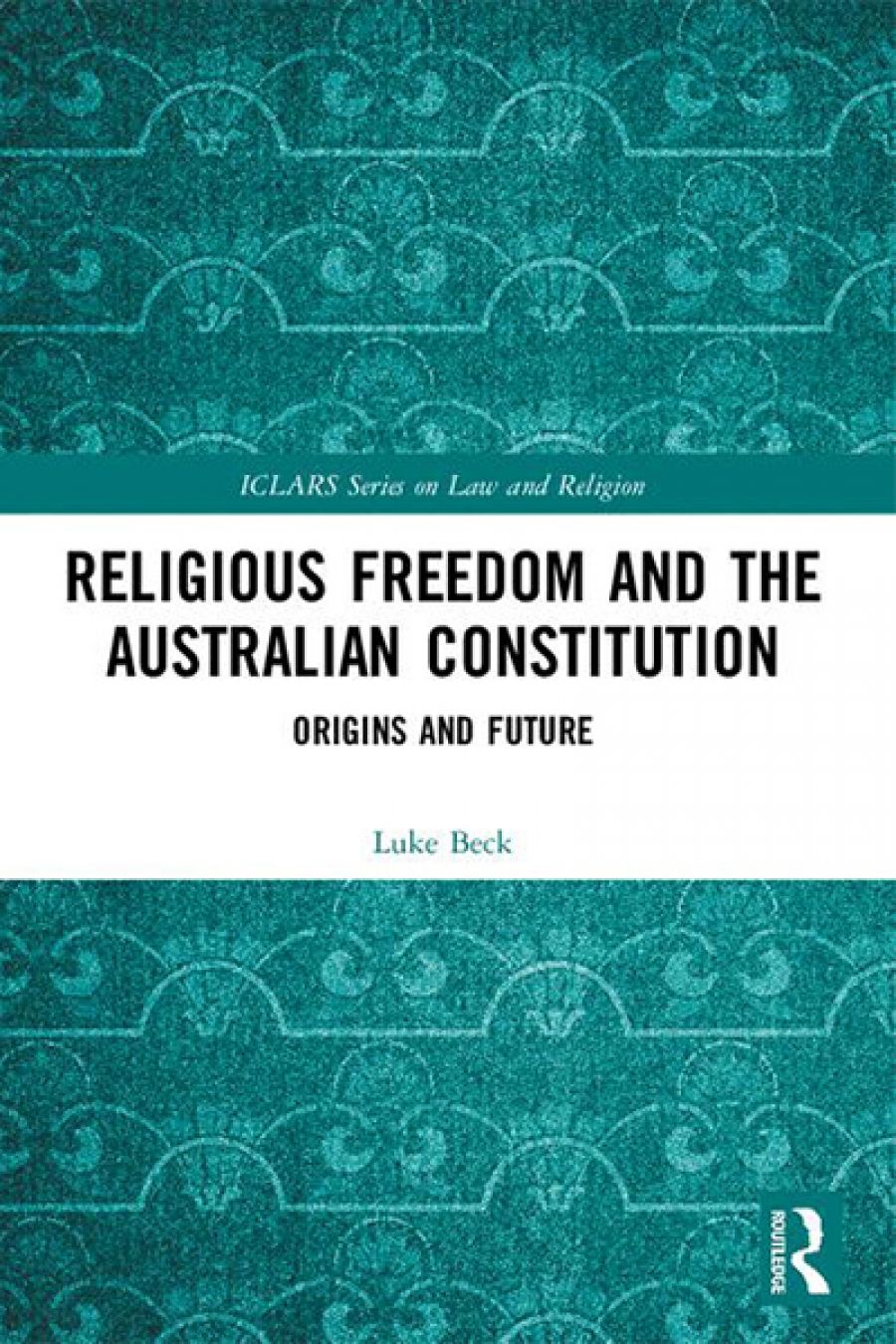
- Free Article: No
- Contents Category: Politics
- Custom Article Title: David Rolph reviews 'Religious Freedom and the Australian Constitution: Origins and future' by Luke Beck
- Custom Highlight Text:
The role of religion in public life in Australia has become a prominent issue again as a consequence of the Australian Marriage Law Postal Survey. Significant opposition to the passage of marriage equality in 2017 was due to the mobilisation of many faiths and denominations. The centrality of religion in the marriage equality debate is best demonstrated by the title of the legislation amending the ...
- Book 1 Title: Religious Freedom and the Australian Constitution
- Book 1 Subtitle: Origins and future
- Book 1 Biblio: Routledge, $242 hb, 288 pp, 9781138555785
The Commonwealth Constitution already provides some degree of protection of religious freedom. Under section 116, the Commonwealth is prohibited from doing four things: making laws to establish a religion, or to impose a religious observance, or to prohibit the free exercise of a religion, or requiring a religious test as a qualification for office. It is not a comprehensive guarantee of religious freedom. This, though, is about as close as the Constitution gets to the entrenchment of an individual right. Australia is unique among Western liberal democracies in having no constitutional or statutory protection of human rights. Australian constitutional law and culture has long been averse to recognising individual rights. Another curious feature of section 116 is that it limits the Commonwealth’s power and says nothing about the States, but it is located in the chapter of the Constitution headed ‘The States’.
The history of this provision is the subject of Religious Freedom and the Australian Constitution by Luke Beck, a constitutional law scholar at Monash University. The story behind this provision, how it came to be in the form it is and where it is in the Constitution, is fascinating. There are many strands to this story and Beck marshals them admirably. There are the experiences of religious minorities, such as the Seventh-day Adventists, the enforcement of Sunday observance laws against them and the political and legal reactions to that. There is the drawing from the experience of United States constitutional law and practice. The drafters of the Commonwealth Constitution variously considered, adopted, adapted, and rejected aspects of United States constitutional law. In an area predating mass communications, let alone digital communications, there is a live issue, well handled by Beck, about which primary and secondary sources of American constitutional law that the drafters of the Commonwealth Constitution had access to. There are also the many debates and resolutions of the various meetings that occurred in cities and regional centres throughout the colonies in the 1890s. As well as crafting a satisfying narrative from these disparate threads, Beck is also effective at evoking the quite different political and cultural milieu in Australia around the time of Federation, where civic Protestantism and sectarianism were features of public life in a way which is alien to the present day.
A significant strength of this book, then, is the engaging way in which it is written. What might otherwise have been quite dry historical, legal, and political material is rendered clearly and effectively. There are some necessary aspects of constitutional theory and law in the book which may be forbidding to the generalist reader. Overall, though, while still being scholarly, Beck has produced an account of the origins of section 116 which would be accessible to the educated, non-expert reader interested in this aspect of constitutional law.
Beyond the historical account of the origins of section 116, Religious Freedom and the Australian Constitution explores the periodic, unsuccessful attempts across the twentieth century to reform it, often in combination with other constitutional reforms. Reforming the Constitution is notoriously difficult, with only eight out of forty-four referenda succeeding since Federation. Given that the prospects for changing the Constitution are so low, an understanding of the origins of section 116 becomes even more important.
Rather than reforming section 116, perhaps a more productive approach is a re-evaluation or reinterpretation of it. Beck argues that the purpose of section 116 has been misunderstood. He contends that the provision is intended to provide a safeguard against religious intolerance, rather than simply placing the Commonwealth in a neutral position in relation to matters of religion. This reinterpretation, if accepted, would give section 116 a greater role than it previously has had. It would affect the way in which contemporary issues, such as the Federal government’s school chaplaincy program, were treated. It would have been interesting to have the impact of Beck’s reinterpretation of section 116 on these topical issues more fully explored in this book. Religious Freedom and the Australian Constitution deals more with the history, rather than the future, of section 116. However, given the ongoing importance of history and context in the interpretation of the Constitution, Beck’s book is a significant contribution to Australian constitutional law scholarship.


Comments powered by CComment